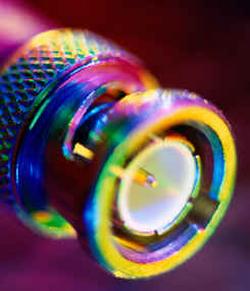Guiding Molecules

Molecules are notoriously difficult to guide and trap. Nevertheless, physicists and chemists have devised increasingly clever methods to control molecular motion. Now a team reports in the 25 September PRL that they have successfully sent a common, but previously unmanageable, class of molecules spiraling along a wire. Although this method can’t yet trap the molecules, the team hopes the breakthrough will soon lead to doughnut-shaped molecular storage rings.
To trap atoms, researchers use lasers and exploit the atoms’ simple quantum energy level structure. Molecules, on the other hand, have a more complex set of energy levels (associated with rotation and vibration) which are incompatible with laser trapping, so molecular physicists guide molecules with electric and magnetic fields instead.
In a nonuniform electric field, a neutral molecule with a permanent electric dipole (a polar molecule) feels a pull in the direction of the strongest electric field, making it a “high field seeker.” But if the molecule is tumbling–and therefore not in its rotational ground state–the field pulls it in the opposite direction, which makes it a “low field seeker.” If the field is strong enough, however, it can force more alignment of the dipole and prevent even a rotationally excited molecule from rotating. Without the rotation, the molecule becomes a high field seeker. So a molecule’s rotational state and the strength of the external field determine whether the molecule is described as low or high field seeking. (More explanation.)
Researchers have previously sandwiched low field seeking molecules between strong electrostatic fields, where they were trapped at an electric field minimum. But as the field is turned up in such a trap, the low field seekers become high field seekers and are lost, rather than becoming more tightly trapped. It’s impossible to configure external fields to create an electric field maximum at the center of an apparatus and catch high field seekers in the same way. No one had trapped or guided high field seekers until Hansjürgen Loesch and Bert Scheel of the University of Bielefeld in Germany came up with a new scheme.
Following predictions from computer simulations, Loesch and Scheel have now guided high field seeking molecules along a tungsten wire threaded through a stainless steel tube. A voltage maintained between the wire and tube creates an electric field that is stronger near the wire, and the molecules travel in a helical path around the wire. The molecules are attracted to the stronger field at the wire, and this small centripetal force holds them in orbit. The molecules’ initial velocity carries them down the length of the tube. Although so far they have only tested NaCl, NaBr, and NaI, Loesch says that additional simulations have shown that all polar molecules could in principle be guided along wires. And by bending the wire guide into a doughnut-shaped toroid, molecules could be trapped by forcing them to spend their lives traveling in circles.
“I really like this paper,” says physicist Gerard Meijer of the University of Nijmegen in the Netherlands. “This is a nice addition to our toolbox to manipulate and trap molecules.” And now that both types of polar molecules can be guided, says Meijer, whose team first trapped the low field seekers, physicists will have unprecedented opportunities to study molecular collisions, probe the quantum energy levels of molecules, and maybe even create a molecular Bose-Einstein condensate.
–Mark Sincell
Mark Sincell is a freelance science writer based in Houston, TX.


